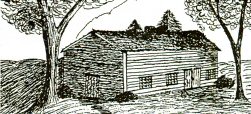
In 1845, Quaker families in the south were becoming more and more unhappy with the poor treatment of African-Americans, the acceptance of slavery and the unrest that predated the Civil War. A few hearty families decided to leave their homes in Jefferson County, Tennessee to travel to a new land further north.
It was a long, tiresome journey, filled with hardships. By winter, they had arrived at Richland in Keokuk County. Early in the spring of 1846 they moved on to Jasper County and settled east of what is now known as Newton. Genealogy records show the following names among this group of settlers: Beals, Bales, Bevan, Hackney, Hammer, Hinshaw, Lewis, Mills and Roberts. Three generations of the Hammer family had decided to make the trip, hence the settlement's original name: Hammers' Grove.

These pioneers immediately began Quaker worship groups in their homes and soon they were able to construct a small "Meeting House" from logs (See picture).
Henry and Hannah Mills Hammer gave three acres of land for this church and a cemetery. The first recorded burial took place in 1855, and this gravestone still stands in Center Friends Cemetery.
More families arrived from North Carolina that shared the vision of freedom for blacks and the group became a stop on the Underground Railroad.
Elisha Hammer began construction of a large brick home and historians' records show that it was [a] well-known site for protecting run-away slaves. The home is mentioned as a safe place in the book No Coward Soul by Vesta O. Robbins. This home is still a well-known landmark, presently owned by Ed and Janet Hagen.
The timber area along the North Skunk River, known as Amboy Woods, was a source of wood for burning and building materials. The Hammer family constructed a saw mill soon after their arrival to the area. The saw mill is presently owned by the Moore family. A map exists, showing that families for miles around owned a small timber tract in this area. The river was a source of ice for residents' ice-houses.
Many native North Americans were living near the river and a friendly and peaceful relationship existed with the settlers. Zola Trout Cleverly's journal describes being invited to share meals in the homes constructed from hides and poles.
With the completion of the railroad (now known as Rock Island) in about 1867, the Amboy neighborhood was able to welcome more families and many new homes were constructed near the railroad line.
A school house was built near the railroad switch station, using bricks from the Seth Hammer's brick yard which was located in the area. At that time, the neighborhood was called Stringtown School. A school was maintained on that site until 1959, when Newton Community Schools reorganized.
A post office was maintained and mail was delivered and distributed with the help of a unique mail receptacle near the railroad. Zola Trout Cleverly's journal describes the use of this mail system prior to the turn of the century. Incoming mail bags were exchanged with outgoing mail from a moving train. Frank Hackney was the postmaster at that time. In approximately 1900, the Stringtown post office was closed and residents traveled to Kellogg to pick up their mail.
The Quaker Church continued to thrive and remain an integral part of the Amboy community. It is speculated that the name Center Friends was decided upon as a result of the many families' ties to the Quaker Church in Centre, N. C.
The worship services did not include preaching by a minister of instrumental accompaniment, but consisted of meditation and prayer. Members were encouraged to share thoughts or a prayer if they felt led to do so.
In 1894 Center Friends sis became a "pastoral meeting." The first recorded minister for the church was Matilda White. New families continued to move and become a part of the Quaker community, many of which were from Amboy, Ind.
It is assumed that this is how the neighborhood's present name Amboy evolved. Center Friends Church celebrated its 100th anniversary in August of 1946. Many people that are presently members of the church are direct descendants of the original founders.
Center Friends congregation is looking forward to a celebration of 150 years of ministering to the community. A date in the summer of 1996 will be chosen for a day of sharing with memories and worship.
At least two century farms in the Amboy neighborhood are still owned by descendants of the citizens who purchased land from the United State Government in the 18050's.
The Amboy community has seen many changes throughout the decades. A commitment to the family and the environment is still shared by those who call Amboy "home." ~ The Newton Daily News, May 15, 1996.